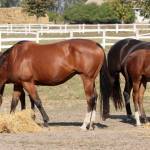Cushing’s Disease: Seasonal Hormone Responses Measured

Fall-onset laminitis in horses has baffled researchers, in part because horses that graze a pasture safely for several months often develop laminitis as the weather chills with no simultaneous change in diet. This seems doubly true of horses suffering from pituitary pars intermedia dysfunction (PPID), also known as Cushing’s disease.
To determine if seasonal hormonal responses differ between normal horses and horses diagnosed with PPID, University of Tennessee researchers studied 17 horses of various ages (8-30 years old), collecting blood samples monthly from August 2007 until July 2008 after pasture grazing and again after stall confinement. The blood was then analyzed for hormone and metabolite concentrations. Pasture grasses were tested for carbohydrate content.
Researchers concluded that PPID did not influence the timing or duration of seasonal adrenocorticotropic hormone (ACTH) concentration, though higher values were noted in horses diagnosed with PPID. Both glucose and insulin concentrations peaked in September when horses were grazing pasture, and this finding could one day help explain the seasonality of laminitis.
The entire article, “Association of season and pasture grazing with blood hormone and metabolite concentrations in horses with presumed pituitary pars intermedia dysfunction,” was printed in the July 28, 2010 issue of Journal of Veterinary Internal Medicine.








